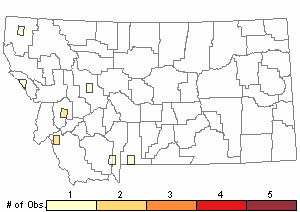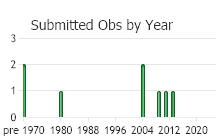View in other NatureServe Network Field Guides
NatureServe
Montana
Utah
Wyoming
Idaho
Wisconsin
British Columbia
South Carolina
Yukon
California
New York
Leafy Bentgrass - Agrostis pallens
Other Names:
Agrostis diegoensis
Native Species
Global Rank:
G4G5
State Rank:
S3S4
(see State Rank Reason below)
C-value:
6
Agency Status
USFWS:
USFS:
BLM:
External Links
State Rank Reason (see State Rank above)
Agrostis pallens has been found in scattered locations within western Montana. There are fewer than 10 collections in the State Herbaria (University of Montana and Montana State University), and where it is present indications of rarity have not been noted. Most herbaria collections were made in and after 1980. This grass may be under-collected because it can easily be mis-identified as another species of Agrostis. Current data on locations, population sizes, habitat, and threats are needed.
- Details on Status Ranking and Review
Range Extent
ScoreF - 20,000-200,000 sq km (~8,000-80,000 sq mi)
Comment31,466 square kilometers
Area of Occupancy
ScoreD - 6-25 4-km2 grid cells
CommentPlant occurs in 7 of the 30,590 4x4 square-kilometer grid cells that cover Montana.
Number of Populations
ScoreB - 6 - 20
Comment7 occurrences
Number of Occurrences or Percent Area with Good Viability / Ecological Integrity
ScoreB - Very few (1-3) occurrences with excellent or good viability or ecological integrity
Comment3 occurrences described as 'common' or 'moderately abundant' and assumed to be of good viability.
Environmental Specificity
ScoreC - Moderate. Generalist or community with some key requirements scarce
CommentIn Montana Agrostis pallens grows in moist to wet meadows.
Threats
ScoreD - Low
General Description
PLANTS: A perennial, rhizomatous (creeping) grass. Stems 60-80 cm tall with most leaves arising from the stems.
LEAVES: Leafy, and generally attached from the lower half of the stem when in flower. Blades are 1.5-11.5 cm long and 2-6 mm wide. When young blades are flat but often become involute (rolled) with age. Ligules 1-6 mm long with the upper margin slightly cut (lacerate), or with irregular notches (erose).
INFLORESCENCE: A contracted to somewhat open panicle with many small flowers, 7–11 cm long. At anthesis (anther dehiscence) the panicle branches spread and ascend. Each node has several primary branches, which branch again along their entire lengths into many small secondary branches.
Spikelets are 3–3.5 mm long, green, yellow-green, or yellow with purple tinges which may make it appear darkish. Glumes are (sub-)equal 2-3.5 mm long, 1(-3) veined, with acute tips. Lemmas are (1.5-)2.2–2.5 mm long, awnless or with an apiculate awn, and with 5 veins which are at least prominent on the upper (distal) portions. Paleas are lacking or minute (to 0.2 mm).
The genus Agrostis comes from the Greek word, agros meaning ‘pasture’ or ‘green fodder’.
Sources: Harvey in FNA 2007; Lesica et al. 2012; and Giblin et al. [eds.] 2018.
Species Range
Montana Range
Range Descriptions

 Native
Native
Range Comments
Leafy Bentgrass grows from British Columbia south into Baja California, Mexico and east to western Montana and Utah (Harvey in FNA 2007).
Observations in Montana Natural Heritage Program Database
Number of Observations: 9
(Click on the following maps and charts to see full sized version)
Map Help and Descriptions
Relative Density

Recency


 (Observations spanning multiple months or years are excluded from time charts)
(Observations spanning multiple months or years are excluded from time charts)
Habitat
Stewardship Responsibility
References
- Literature Cited AboveLegend:
 View Online Publication
View Online Publication Flora of North America Editorial Committee, eds. 2007. Flora of North America North of Mexico. Volume 24. Magnoliophyta: Commelinidae, Part 1. Oxford University Press, Inc., NY. xxxiii + 911 pp.
Flora of North America Editorial Committee, eds. 2007. Flora of North America North of Mexico. Volume 24. Magnoliophyta: Commelinidae, Part 1. Oxford University Press, Inc., NY. xxxiii + 911 pp. Hitchcock, C.L. and A. Cronquist. 2018. Flora of the Pacific Northwest: An Illustrated Manual. Second Edition. Giblin, D.E., B.S. Legler, P.F. Zika, and R.G. Olmstead (eds). Seattle, WA: University of Washington Press in Association with Burke Museum of Natural History and Culture. 882 p.
Hitchcock, C.L. and A. Cronquist. 2018. Flora of the Pacific Northwest: An Illustrated Manual. Second Edition. Giblin, D.E., B.S. Legler, P.F. Zika, and R.G. Olmstead (eds). Seattle, WA: University of Washington Press in Association with Burke Museum of Natural History and Culture. 882 p. Lesica, P., M.T. Lavin, and P.F. Stickney. 2012. Manual of Montana Vascular Plants. Fort Worth, TX: BRIT Press. viii + 771 p.
Lesica, P., M.T. Lavin, and P.F. Stickney. 2012. Manual of Montana Vascular Plants. Fort Worth, TX: BRIT Press. viii + 771 p.
- Additional ReferencesLegend:
 View Online Publication
View Online Publication
Do you know of a citation we're missing? Amme, David. No Date. California Agrostis (Bentgrass).
Amme, David. No Date. California Agrostis (Bentgrass). Boggs, K. W. 1984. Succession in riparian communities of the lower Yellowstone River, Montana. M.S. Thesis. Montana State University, Bozeman, 107 pp.
Boggs, K. W. 1984. Succession in riparian communities of the lower Yellowstone River, Montana. M.S. Thesis. Montana State University, Bozeman, 107 pp. Culver, D.R. 1994. Floristic analysis of the Centennial Region, Montana. M.Sc. Thesis. Montana State University, Bozeman. 199 pp.
Culver, D.R. 1994. Floristic analysis of the Centennial Region, Montana. M.Sc. Thesis. Montana State University, Bozeman. 199 pp. Del Moral, Roger, and David M. Wood. 1988. Dynamics of Herbaceous Vegetation Recovery on Mount St. Helens,Washington, USA, after a Volcanic Eruption. Vegetatio, Vol. 74. No. 1, pp. 11-27.
Del Moral, Roger, and David M. Wood. 1988. Dynamics of Herbaceous Vegetation Recovery on Mount St. Helens,Washington, USA, after a Volcanic Eruption. Vegetatio, Vol. 74. No. 1, pp. 11-27. Lesica, P., M.T. Lavin, and P.F. Stickney. 2022. Manual of Montana Vascular Plants, Second Edition. Fort Worth, TX: BRIT Press. viii + 779 p.
Lesica, P., M.T. Lavin, and P.F. Stickney. 2022. Manual of Montana Vascular Plants, Second Edition. Fort Worth, TX: BRIT Press. viii + 779 p.
- Web Search Engines for Articles on "Leafy Bentgrass"





